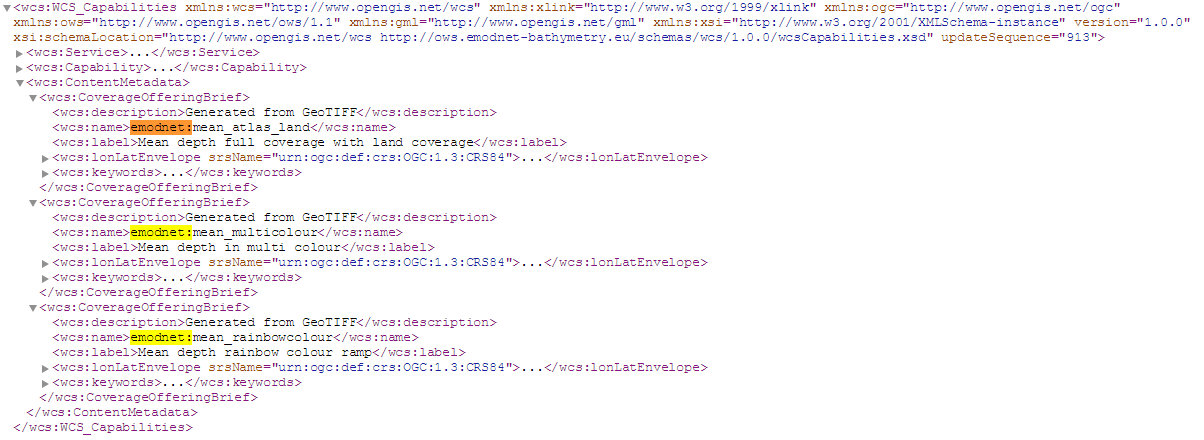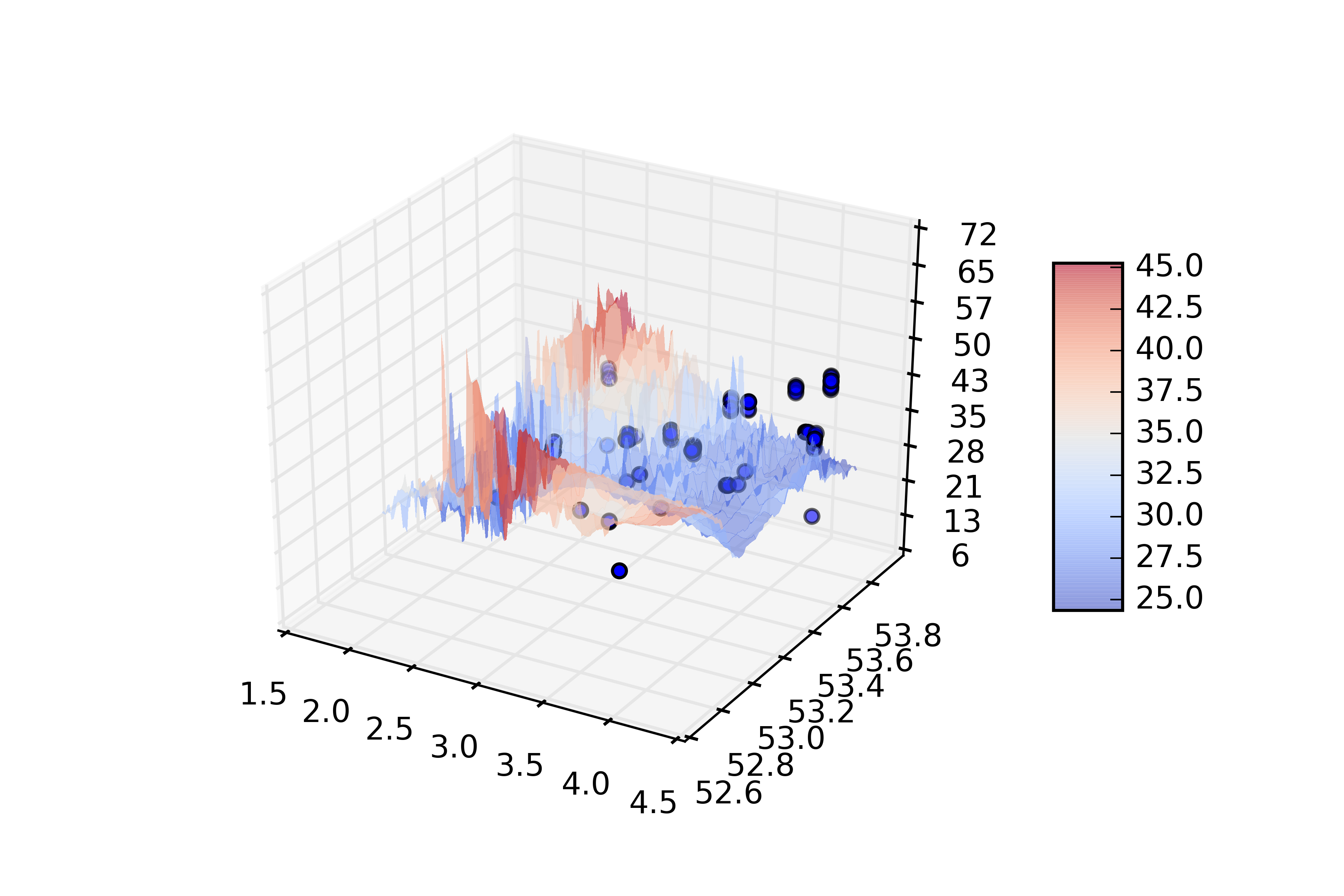...
- go to the catalogue of EMODnet to find the data sets, these are:
- bathymetry
- biotic observations (without some specific knowledge it is hard to find dataset(s) where abundance information of Amphiura filiformis can be found)
- Go to the specific subportals via the links presented above and find out which services are available, these are:
- for bathymetry the following services are made available
WCS gives you the real data. The example will be worked out for this service. Find out more about WCS at the page WCS primer. - for biotic observations the challenge is to find abundance information on the VLIZ geoserver
Geoserver can advertise WMS, WFS and WCS information, in case of species distribution in relation to depth the real observations are the way to go. Read more about WFS at the WFS primer page. Checking the complete geoserver and filtering on Eurobis it reveals the best dataset to be used is Aggregated points (stations) of EurOBIS occurences.
- for bathymetry the following services are made available
At this point insight is gained in the available sources and possible datasets that can be used. Close investigation reveals however that Bathymetry is not really usable. Reverse engineering via the downloade area of interest button on the EMODnet bathymetry portal reveals that the dataset with the real data is not advertised. This is shown via the get capabilities request of the WCS services provided.
Code Block language xml title WCS GetCapabilities http://ows.emodnet-bathymetry.eu/wcs?service=WCS&request=GetCapabilities&version=1.0.0
this gives:
The developer tools gives information that a different layer is used, the coverage emodnet:mean is not mentioned in the getCapabilities but is used as layer to download.
- Now a list of exact datasource is know, these are:
- for bathymetry (http://ows.emodnet-bathymetry.eu/wcs? coverage emodnet:mean)
- for biota (http://geo.vliz.be/geoserver/Eurobis/ows? layername=Eurobis:eurobis_points)
On the primer pages present code snippets for python. These code snippets are adjusted to the particular example presented here.
Code Block language py title WCS code snippet # import packages import os from owslib.wcs import WebCoverageService from osgeo import gdal # define the connection url = 'http://ows.emodnet-bathymetry.eu/wcs?' wcs = WebCoverageService(url,version='1.0.0',timeout=320) wcs.identification.type wcs.identification.title # define variables clipfile = r'..\temp.tif' requestbbox = (2.097,52.715,4.277,53.935) layer = 'emodnet:mean_atlas_land' # get the data bathyml = 'emodnet:mean' sed = wcs[layer] #this is necessary to get essential metadata from the layers advertised sed.keywords sed.grid.highlimits sed.boundingboxes cx, cy = map(int,sed.grid.highlimits) bbox = sed.boundingboxes[0]['bbox'] lx,ly,hx,hy = map(float,bbox) resx, resy = (hx-lx)/cx, (hy-ly)/cy width = cx/1000 height = cy/1000 gc = wcs.getCoverage(identifier=bathyml, bbox=requestbbox, coverage=sed, format='GeoTIFF', crs=sed.boundingboxes[0]['nativeSrs'], width=width, height=height) fn = clipfile f = open(fn,'wb') f.write(gc.read()) f.close() filetiff = gdal.Open(clipfile) theImage = filetiff.GetRasterBand(1).ReadAsArray() os.unlink(clipfile)
for querying the WFS following code is used
Code Block language py title WFS querying # import the packages import pandas import sys import os from owslib.fes import * from owslib.etree import etree from owslib.wfs import WebFeatureService # define the input variables requestbbox = (2.097,52.715,4.277,53.935) fn = r'..\afile' wfs = 'http://geo.vliz.be/geoserver/Eurobis/ows?' layer = 'Eurobis:eurobis_points' afilter = PropertyIsEqualTo(propertyname='Eurobis:ScientificName', literal='Amphiura filiformis') # define the link to the service and carry out the request wfs11 = WebFeatureService(url=wfs, version='1.1.0',timeout=320) response = wfs11.getfeature(typename=layer, bbox=bbx,srsname='urn:x-ogc:def:crs:EPSG:4326',outputFormat='shape-zip') if os.path.isfile(fn): os.unlink(fn) out = open(fn, 'wb') out.write(response.read()) out.close() # define pandas dataframe for the output out = open(fn, 'wb') out.write(response.read()) out.close() df = pandas.read_csv(fn,header=0,sep=',') os.unlink(fn)Now the result (if there is data in the boundingbox, there is no testing involved, zou the result can be empty, this is not tested) is there in 2 objects (Pandas DataFrame and a Numpy array). This can be plotted in a 3D Scatter plot using the Matplotlib. See next code.
Code Block language py title Plotting the data img = theImage (see above) bbox = requestbbox (see above) def plotraster(img,df,resx,resy,bbox): from mpl_toolkits.mplot3d import Axes3D import matplotlib.pyplot as plt from matplotlib import cm from matplotlib.ticker import LinearLocator, FormatStrFormatter import numpy as np fig = plt.figure() ax = fig.gca(projection='3d') #plot the vectors xv = df['Longitude'] yv = df['Latitude'] zv = df['MaximumDepth'] ax.scatter(xv,yv,zv,label=df['ObservedIndividualCount']) # Make data. X = np.linspace(bbox[0],bbox[2], img.shape[1]) Y = np.linspace(bbox[1],bbox[3], img.shape[0]) X, Y = np.meshgrid(X, Y) #R = np.sqrt(X**2 + Y**2) #Z = np.sin(R) Z = img # Plot the surface. surf = ax.plot_surface(X, Y, Z, cmap=cm.coolwarm, linewidth=0, antialiased=False,alpha=0.5) # Customize the z axis. ax.set_zlim(Z.min().round(), Z.max().round()) ax.zaxis.set_major_locator(LinearLocator(10)) ax.zaxis.set_major_formatter(FormatStrFormatter('%.f')) # Add a color bar which maps values to colors. fig.colorbar(surf, shrink=0.5, aspect=5) plt.savefig(r'd:\temp\emodnet\test.png',dpi=600) plt.show()The result is visualised in the following graph



